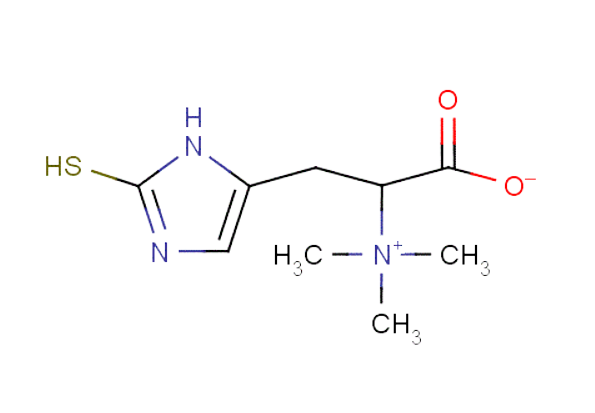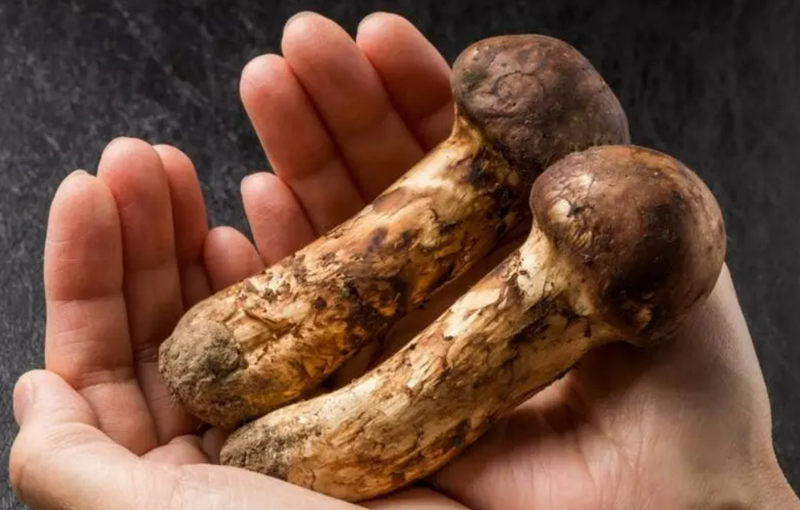Ergothioneine is a naturally occurring amino acid containing a sulfur atom on the imidazole ring. This compound was originally discovered in mushrooms and other animals in 1909 by French pharmacist Charles Tanret while investigating the ergot fungus Claviceps purpurea. It was also found in plants, where it is concentrated in the erythrocytes, skin, and kidneys. Nowadays the benefits of Ergothioneine have been more and more popular in healthy supplements and cosmetics products.
Ergothioneine is a naturally occurring cell protector and antioxidant in the body, but we can’t make it ourselves and can only take it from the outside. The amino acid ergothioneine is an important part of proteins and can be found in many foods. It has been found that plants, such as red beans, broccoli, mushrooms and oat bran, and other sources. It is also present in human breast milk. Other food sources with lower levels of ergothioneine include pork, chicken, crab, and lamb. Earlier studies have shown that mushrooms are high in ergothione, and eating them is thought to boost levels in the body. In recent years, ergothione has been widely studied in the fields of medicine, food and cosmetics because of its powerful antioxidant and cellular protective physiological functions.
How the ergothione was made?
Ergothioneine can be prepared by three methods: chemical synthesis, biological extraction and biological fermentation.
It is very difficult to synthesize l-ergothione by chemical methods. Several methods failed to achieve the expected yield due to partial or total racemization. The difficulty of synthesis is that it is difficult to prepare 2-mercaptoimidazole as raw material, and the acid of α -position carbon makes the reaction prone to racemization. OXIS International was the first company to develop and patent a highly efficient and commercial method for the synthesis of ergothionein by introducing a sulfhydryl group into an imidazole ring in 1995. However, the application of ergothionein is still limited by high raw materials and cost because the safety of chemical synthesis products is difficult to be guaranteed.
The natural biological extraction method is to extract ergothionein from fruiting body of edible fungus, pig blood, animal tissue, ergothionein and grain, but the content of ergothionein in these raw materials is still very low, and there are many impurities in raw materials, drug residue and high extraction cost.
The biosynthesis of ergothionein by deep fermentation technology of fungoides mycelium is the mainstream direction of low-cost&large-scale production of ergothionein, which can effectively improve the production of ergothionein and reduce its cost by means of fermentation process control such as metabolic regulation. More importantly, this method can ensure the safety of the product. Ergothionein was produced by the combined fermentation of hericium ordosica and pine mushroom mycelium in most Chinese manufacturers.
Why is Ergothioneine so expensive?
At present, the price of ergothionein claimed by Chinese manufacturers of 98%-99% purity is generally around 1000 RMB/g, and different manufacturers vary a lot due to the productivity of fermentation and different chemical synthesis methods. The price of ergothione from Huaxi Biological, a giant Chinese biotechnology company, is about 7,500 yuan /g. The raw material is a mixed liquid with a content of about 0.013%. In addition, different access, purity and quality ultimately determine the price of ergothiain.
Why is ergothiain so expensive? Because the material itself is expensive. Pine mushroom, one of the extracted sources, belongs to the endangered protected species in China. Pine mushroom grows very slowly and generally takes 5-6 years to grow, but it only takes about 7 days for the fruit body to mature from the excavation. Once mature for 48 hours, the mushroom will rapidly age and decay. In addition, it likes to grow in relatively dry or pollution-free virgin forests under pine trees more than 50 years old, spores must also symbiosis with the roots of pine trees to form mycelia and ponds. It is precisely because of such harsh conditions that the artificial cultivation of the mushroom did not succeed even in Japan.
At Rainbow Biotech, we can also manufacture L-ergothiain powder from pine mushrooms if you have an order of more than 500kg, the high purity and low price can be guaranteed by our advanced R&D team. Consult our sales representative for more details.
Benefits of Ergothioneine
It has been studied in mice for over 100 years and is GRAS-approved for use in functional food and supplements. The benefits of ergothioneine are largely unknown, however, so it is important to have a basic understanding of what this amino acid does for our body.
Antioxidation
As a potent antioxidant, glutathioneine is a key ingredient in cellular immunity. Studies have shown that ergothioneine is even more powerful than glutathione. Research on ergothioneine has shown promising results in terms of its antioxidant properties. It is a potent thiol buffering antioxidant, with an efficiency greater than coenzyme Q(10). Research has also shown that ergothioneine reduces the levels of free radicals in human skin cells and protects the integrity of DNA from oxidative stress. It can effectively remove -OH, chelate iron and copper ions, prevent H2O2 from generating -OH under the action of iron or copper ions, inhibit the oxidation of copper ion-dependent oxygenated hemoglobin, and inhibit the oxidation of arachidonic acid when myoglobin (or hemoglobin) is mixed with H2O2. Ergothionein also powerfully removes hypochlorous acid, thereby preventing a 1- antiprotease inactivation. However, it does not inhibit lipid particles from peroxidation in the presence of iron ions.
Cell protection
Ergothione is a powerful hypochlorite scavenger (HOCl), and while many compounds react with hypochlorite, few react as quickly as ergothione. Ergothioneine has been found to reduce inflammation in cells, a process that is associated with aging and disease. Ergo also acts as a chelating agent, binding copper and iron which promote free radical damage. Ergo has also been shown to modulate apoptosis, which is the process of programmed cell death. However, research on this supplement has shown that it may have many other benefits.
Applications of Ergothioneine
The study found that adults 60 and older who ate more mushrooms had lower rates of mild cognitive impairment. So ergothione from mushrooms and ergot fungi may delay the onset of neurodegenerative disease. Extensive evidence shows that ergothione has a rich antioxidant function, which can effectively scour the body of reactive oxygen species, and free radicals, and protect cells from the effects of reactive nitrogen and ultraviolet radiation.
Real Mushrooms has a supplement called ERGO+ that contains five milligrams of L-ergothioneine per capsule. It also contains extracts of Shiitake and Oyster mushrooms, which produce ergothioneine naturally. This combination delivers a host of health benefits. The ergothione can be made into tablets, capsules, oral preparations for the treatment of inflammation, etc., as a raw material added to cosmetics to sunscreenn, repair, and whitening due to antioxidant and cell protection. Estee Lauder, Clinique, Elizabeth Arden and other brands add this ingredient to their products for years.
- Dandelion Extract: What It Is, Benefits, Uses and Side Effect - April 23, 2024
- Is Berberine Extract Help For Weight Loss? - April 11, 2024
- Why Is Pysllium Husk Powder A Popular Meal Replacement Ingredient? - April 3, 2024





